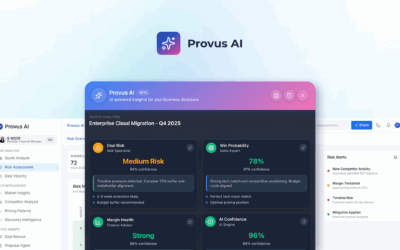Professional services are entering a new era—one where pricing isn’t defined by time and effort, but by intelligence and outcomes.
In a recent Provus webinar, Chris Murphy, Chief Revenue Officer at Thoughtworks, joined Stawan Kadepurkar, CEO of Provus, to discuss how the rise of agentic systems is transforming how services are delivered, valued, and priced.
Read a summary of the webinar below, and watch the recording at any time.
From time and materials to value and outcomes
For decades, professional services organizations have priced work through a familiar lens: time and materials.
“Our predominant model for charging has been charging on a time and materials basis,” said Murphy. “It was a rough proxy for value—it worked, but it was inadequate, particularly for clients.”
That model no longer holds. “The provision of value in this new agentic world is not going to be delivered only through people,” Murphy explained. “It’s going to be delivered through people, products, agents, and accelerators. What’s able to be delivered in this new world is not just ten times, but potentially a hundred times, depending upon how you bring those together.”
He calls this “the golden era of professional services” one defined by reinvention. “We’re going to see a rapid bifurcation between those that are really leaning into it and those that are stuck in the past, which I think is increasingly, if not already, a problematic place to be.”
The rise of value-based pricing
When asked whether value-based pricing is more hype than reality, Murphy’s response was clear. “It’s real. What I think is that the future of value-based pricing is unevenly distributed,” he said.
He believes this shift is customer-led. “What we’re seeing now is a real, fundamental, and accelerating shift in client expectations,” he said.
From cost-up to value-down
Murphy describes what he sees as one of the most profound shifts in the services business: a complete inversion of how pricing begins.
“Pricing in the future is flipping that on its head,” he explained. “It’s not a cost-up approach. This is a top-down approach of saying, let’s start with the value that’s being co-created for our customers.”
That shift changes everything—from how companies structure deals to how they think about cost itself. As Murphy put it, “The cost base is going to be a combination of people and tokens—the agents that we run, the tokens that they consume—and the cost of products and accelerators.”
In other words, the traditional calculus of hours and rates no longer applies. The focus now is on the outcome being delivered and the value that outcome creates. From a pricing perspective, it’s not about effort anymore. It’s about value.
And when organizations get it right, the upside is dramatic. “In a time and materials world, even if you are delivering ten times the value of your competitors, you can probably at best charge twenty percent more,” Murphy noted. “Now, there is the ability to achieve ten, twenty, fifty times more.”
Operational readiness for the agentic era
Murphy acknowledges that the industry has been comfortable for too long. “We as an industry have been a bit complacent,” he said. “It’s been too easy to fall back on time and materials pricing.”
That rethink begins internally. “We have to educate our own people,” he said. “Many of our employees are very familiar with the old ways. We also have to educate our clients and their procurement departments. But they want to be educated. All our clients are asking us, what does this mean? How do we do more of this?”
Forecasting in the new model
Transitioning to value-based pricing introduces complexity in forecasting, but Murphy says predictability isn’t lost, it’s just redefined. “We’ve all trained forecast models that are trained on a different pricing paradigm,” he said.
“Now we’re moving into a world where how we establish the models matter,” said Murphy. “You start making estimates around that, when those milestones should be achieved, you build them into a portfolio view, and then you can start deriving high levels of confidence around what that looks like.”
He added, “Pricing is becoming more sophisticated, more complicated. Modeling becomes more important than ever.”
What leaders should do now
Murphy’s guidance for services organizations is straightforward:
- Start with outcomes, not hours. Anchor every quote to what the client is truly trying to achieve.
- Rebuild the cost model. Understand how people, tools, and agents together create value—and price accordingly.
- Invest in modeling tools. Use data to understand impact, forecast scenarios, and reinforce confidence.
- Lead the education. Help your teams and your clients move beyond traditional pricing logic.
The new era of professional services
“Professional services is not going away,” Murphy concluded. “But it’s fundamentally having to reinvent itself. Value-based pricing and pricing generally are going to be at the heart of that reinvention.”
And he left the audience with one final reflection:
“I wholeheartedly believe that this is the single most exciting time in professional services in the last hundred years. And aren’t we all very privileged to be in it?”







